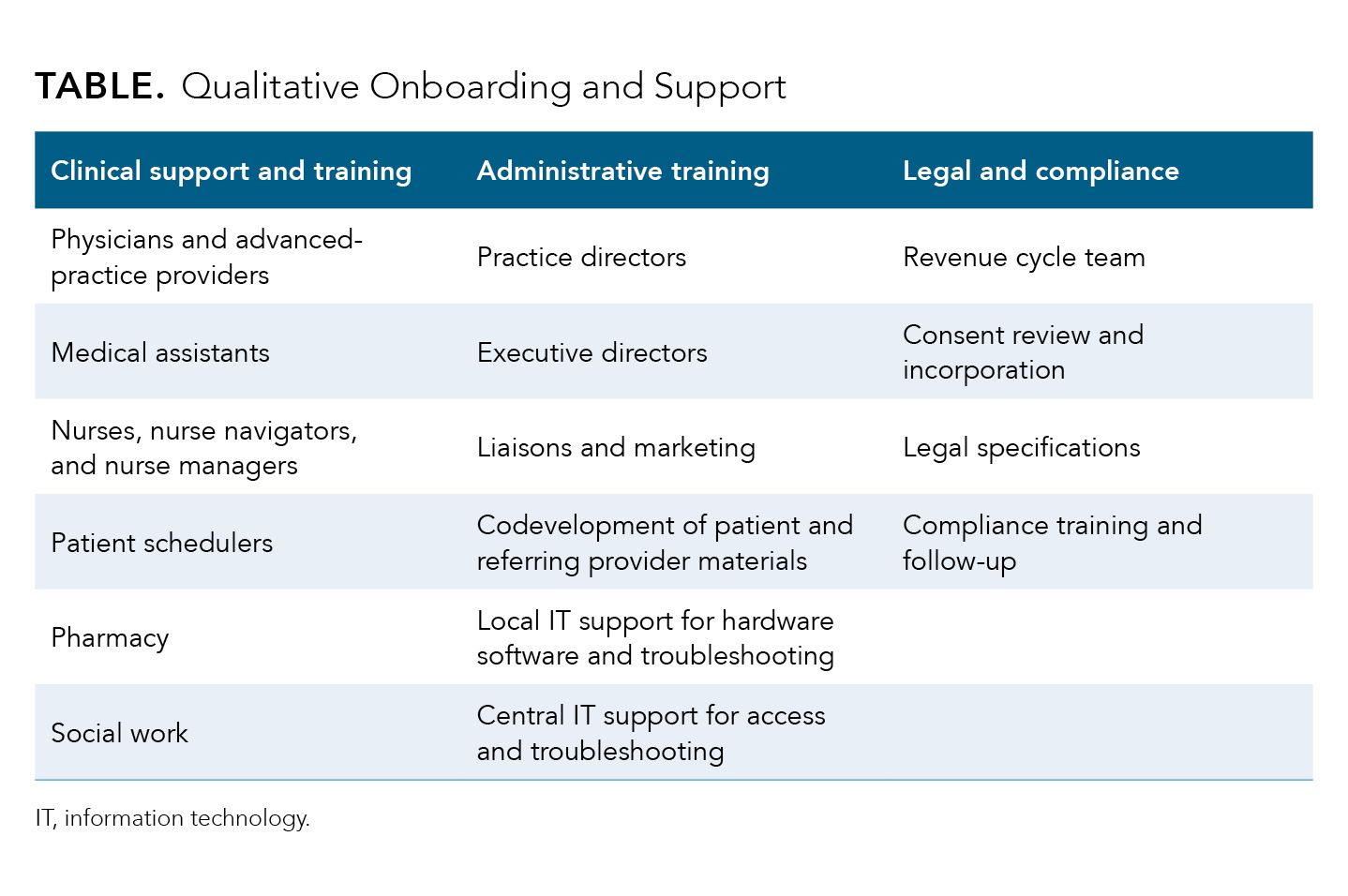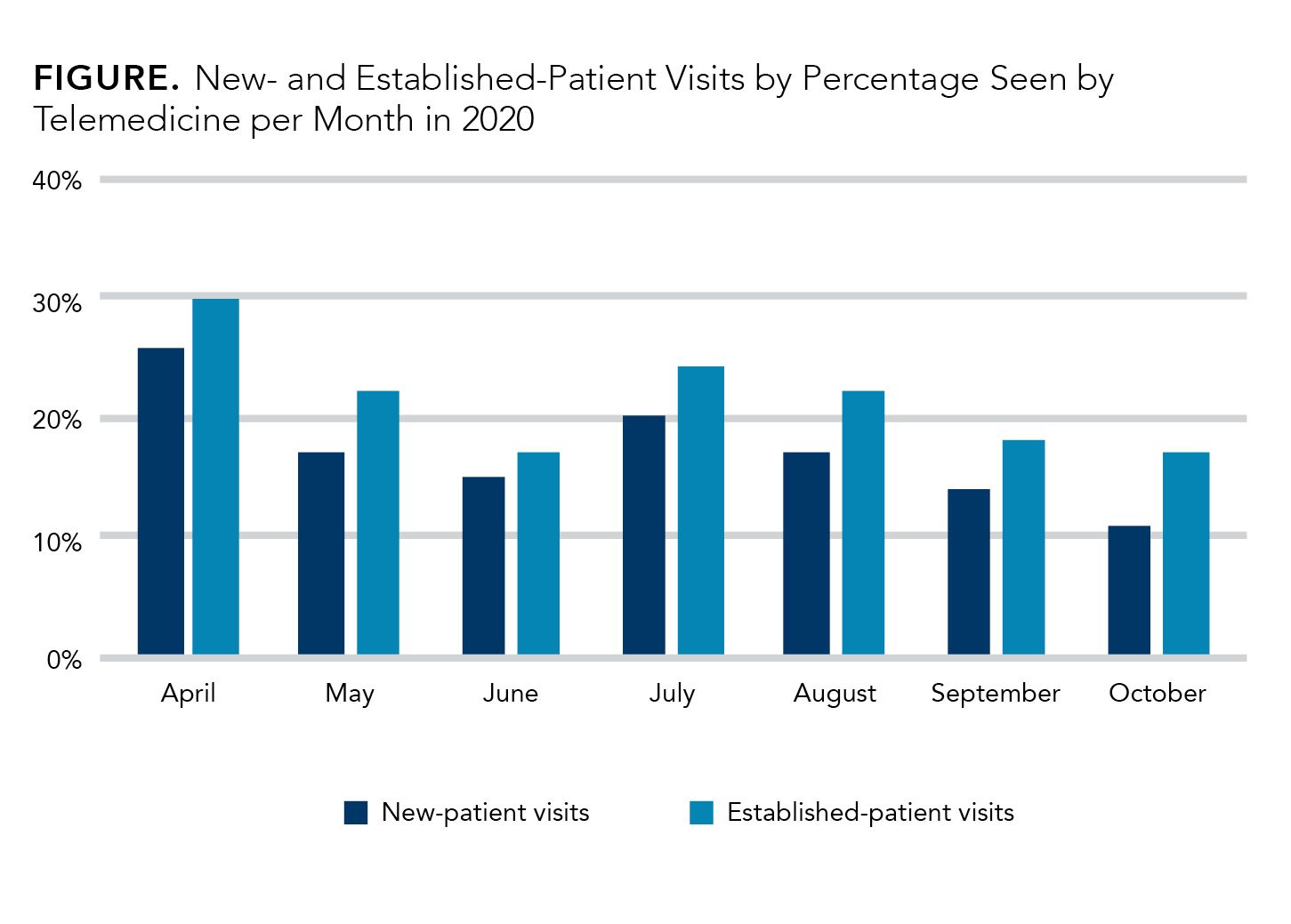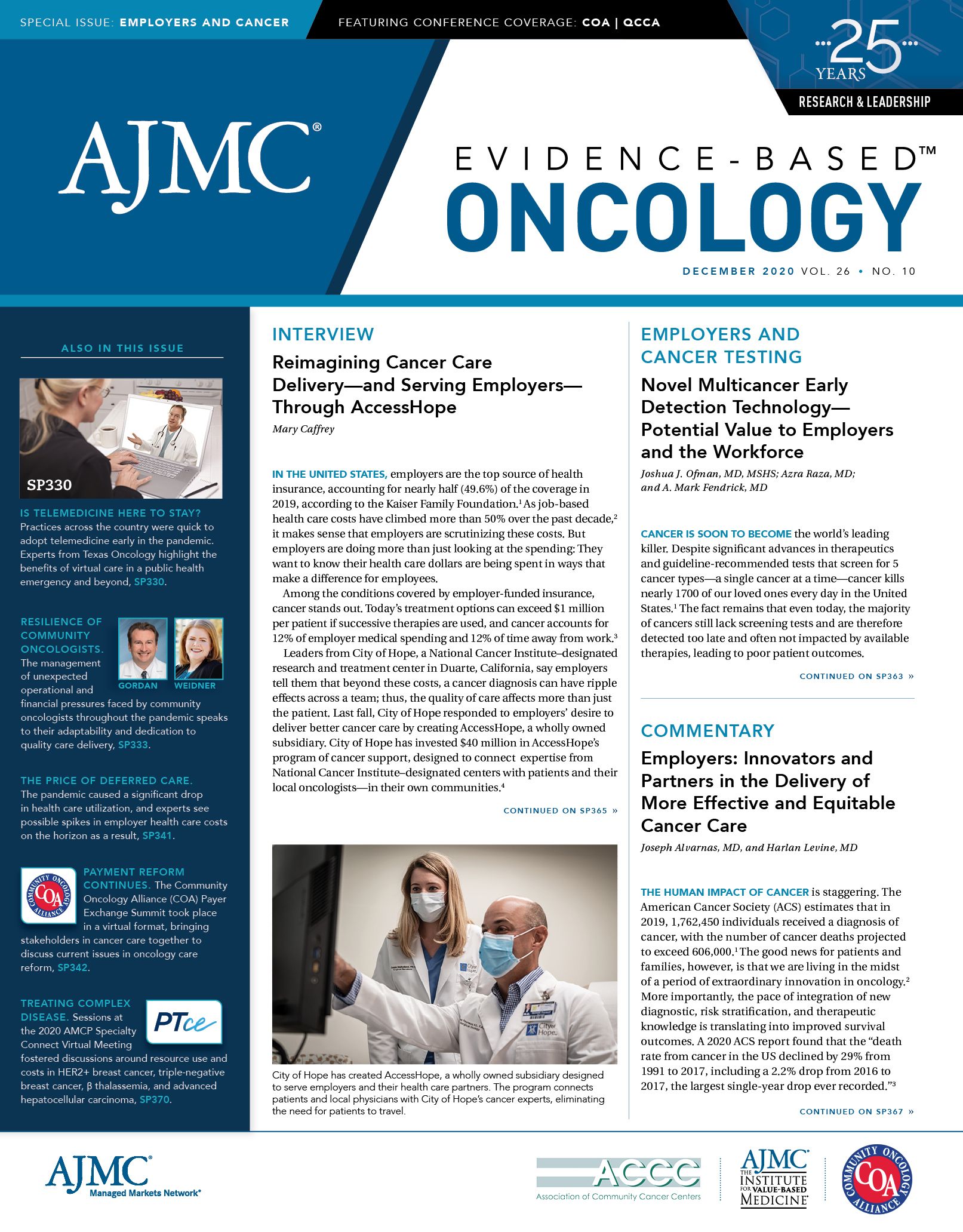- Center on Health Equity & Access
- Clinical
- Health Care Cost
- Health Care Delivery
- Insurance
- Policy
- Technology
- Value-Based Care
Telemedicine for Cancer Care: Implementation Across a Multicenter Community Oncology Practice
Texas Oncology physicians discuss utilization of telemedicine, evaluating trends, barriers, and opportunities in care delivery during the coronavirus disease 2019 pandemic.
ABSTRACT
Purpose: To describe onboarding and utilization of telemedicine across a large statewide community oncology practice and to evaluate trends, barriers, and opportunities in care delivery during the coronavirus disease 2019 pandemic.
Methods: We describe telemedicine onboarding and utilization across a statewide oncology practice, covering 221 sites of service and more than 650 practitioners. We describe qualitatively the onboarding process of a diverse set of administrative, technical, and clinical partners. We describe quantitatively utilization throughout the practice. We describe a survey conducted to enlighten barriers and opportunities for optimal utilization.
Results: Multistakeholder education was directed to clinical teams, administrative and technical support staff, and patients through webinars and team meetings. Utilization was high from April through October 2020, representing 15% to 20% of new-patient visits and 20% to 25% of established-patient visits. In a survey offered to all clinicians, 96% of respondents indicated they are using telemedicine, with 33% using it for more than 25% of patient encounters. Among respondents, 59% reported that the use of telemedicine helps expedite diagnosis and treatment more than seeing patients in person in the clinic, 55% of respondents managed urgent issues by telemedicine, 80% believed that patients benefited from urgent assessment by telemedicine, and 57% believed an emergency department visit or a hospitalization was avoided because of a telemedicine visit. Most clinicians reported that patients enjoy benefits of telemedicine because of decreased exposure risk, decreased transportation requirements, and ease of including caregivers in the visit with the treating clinician. The most common barriers to patients accessing telemedicine were technical challenges and broadband access. Despite this, less than 5% of respondents routinely use telephone-only communication, as most typically use bimodal audio/video communication. Many clinicians have expansion ideas on how telemedicine can further expand the longitudinal care delivery for our patient population.
Conclusions: Telemedicine can be implemented successfully across a large statewide oncology practice and service a high volume of patients. Clinicians utilize telemedicine for new and established patients with minimal dysfunction. Clinicians believe patients benefit from telemedicine for new, established, and urgent care visits. Broadband access functionality should be explored to optimally serve our patient population.
https://doi.org/10.37765/ajmc.2020.88560
BACKGROUND
Telemedicine has been launched broadly across practices in the United States during the coronavirus disease 2019 (COVID-19) pandemic after rapid policy changes occurred in March 2020 at the federal and state levels.1 Telemedicine was implemented to allow clinicians to continue to serve patients while reducing the risk for both patients and the clinical staff who serve them. Because the policies that govern telemedicine were implemented very broadly to facilitate rapid uptake, wide variability exists in how services are provided and in process workflow to improve implementation. Prior to the COVID-19 pandemic, much of the policy and processes that guide telemedicine were based on models of singular office visits for acute care or relatively infrequent second-opinion consultations.2 With the broad launch of telemedicine during the COVID-19 pandemic, we have the opportunity to understand its rich value in the longitudinal care of patients with cancer; unlike the on-demand models that preceded it, telemedicine in the pandemic is being embraced by clinicians who have longstanding relationships with their patients. There is broad patient satisfaction with the use of telehealth, and this has been predominantly evaluated in longitudinal subspecialty settings.3 Clinicians also demonstrate high levels of satisfaction. There is great interest in understanding how telemedicine can be optimally utilized to improve cancer care delivery and, now that we are more familiar with this tool to deliver high-quality care, to understand how we can grow and expand on it to continue to further care delivery.4
METHODS
We describe qualitatively and quantitatively onboarding from February through April 2020 across multiple stakeholder groups and utilization of telemedicine services across our statewide oncology practice with more than 650 providers at 221 sites of service. Through this process, we seek to understand drivers of effective implementation and barriers and opportunities for quality improvement in care delivery. We describe results from a clinician survey to understand how clinicians are using the platform, when they found it useful, barriers to use, and opportunities to maximize performance.
RESULTS
Onboarding
Registration and onboarding began in February. Clinician training consisted of education about the policies that permitted broader launch of telemedicine, how to use the selected private Health Insurance Portability and Accountability Act (HIPAA)–compliant platform, how patients would interact with the platform, legal and compliance requirements, liaison- and patient-facing materials, and payment policy. Recurring webinars presenting new information and soliciting feedback were conducted at weekly intervals for 6 weeks and again at less frequent intervals. Newer content included how to add additional participants to the virtual visit; new process workflows to enter patients into the virtual waiting room; how symptom, medication, and pharmacy review would be conducted by the medical assistant prior to the clinician encounter; billing updates; and troubleshooting information. Clinical staff developed a process workflow to incorporate previsit tasks to emulate the in-person visit as much as possible. Medical assistants, practice directors, nurses, and schedulers were then educated on these workflows with webinars in March, and team feedback was encouraged to make sure communication gaps would not lead to challenges in functionality. Technology services staff at the state and local levels participated in webinars and were educated on specification requirements for patients, clinicians, and staff; audio and video needs were assessed and achieved in office or home settings as appropriate. The marketing team was engaged to work with the platform vendor, and patient-specific content was developed to educate patients and caregivers about the platform to optimize the telemedicine visit. Liaisons offered webinars about telemedicine, with information on where referring providers could find information on the website and how patients would optimally interact with the platform. Liaisons were also given handouts created for referring providers so they would be aware that patients could be seen and how visits would occur. The oncology practice worked to create patient information on the website, with both local and central resource, identified for patients, clinicians, and administrative staff for troubleshooting problems. We engaged legal and revenue cycle teams regarding specification requirements and billing compliance and, later, social work, pharmacy, and patient assistance specialists (Table).
Qualitative Onboarding and Support Table

Utilization
Prior to onboarding, some physicians were using the platform to see patients in other parts of
the state, though total utilization was less than 1% of total patient visits. As onboarding commenced, most practitioners started to utilize the platform immediately, and by April, telemedicine visits represented 25% of new-patient visits and 30% of established-patient visits. From April through October, on average, telemedicine comprised 15% to 20% of new-patient visits and 20% to 25% of established-patient visits in most months (Figure).
New and Established Patient Telemedicine Visits

In August, a survey was sent to the clinicians in our practice. Among the respondents, 77 of 80 stated they believe telemedicine is a useful tool to care for patients. Respondents reported that:
- 99% are using bimodal communication through our preferred HIPAA-compliant platform to conduct virtual visits;
- 65% are using telemedicine for more than 10% of patient visits, but only 7.5% of respondents are using it for more than 50% of patient visits;
- 59% conducted new-patient visits using telemedicine, and 64% of those who were conducting new-patient visits through telemedicine felt that it helped expedite patients’ diagnosis and treatment; and
- 55% of respondents were using telemedicine to manage urgent patient issues, and 57% of those respondents believe an emergency department (ED) visit or hospitalization was avoided using telemedicine.
Common urgent issues that were addressed that allowed patients to avoid an ED visit or a hospitalization included symptom management, nausea, pain, fever, rash, cellulitis, deep venous thrombosis, and port evaluation. The majority of respondents felt that patients benefited from telemedicine because they avoided going to the clinic, they were able to easily include their caregivers in the visit, and there was decreased exposure to COVID-19. The majority of barriers to using telemedicine effectively included technical challenges in getting on the platform and lack of broadband access sufficient for a bimodal connection. Only 9% of respondents reported that patient unwillingness was a large barrier to using telemedicine effectively. Among respondents, 93% of clinicians were working with their teams to optimize the telemedicine experience for their patients, and 70% of respondents believed it increased the workload for support staff by more than 10%. Clinicians felt that telemedicine may be useful to expand to social work, dietitian visits, financial counseling visits, care coordination around chemotherapy visits, genetic counseling visits, nurse navigator follow-up after hospitalization, weekend triage visits, multidisciplinary meetings, and advanced care planning visits.
DISCUSSION
Telemedicine was broadly implemented across the practice with the intent to continue to provide high-quality cancer care while reducing the risk for patients and staff. Although it is more difficult for staff and clinicians, telemedicine provides a high-value service to patients as well as convenience and risk reduction.
Clinically, there have been many additional insights gained from experience with telemedicine. Our social workers have been leading virtual support groups to care for patients during the crisis. These support groups have been very well received, and the groups have grown to meet the demands of our patient base. We have been piloting telepharmacy, which has been useful for patient assistance. Clearly, there are opportunities to use telemedicine to manage and support longitudinal care of patients.
Operationally, telemedicine has also offered substantial benefits. When patients fail symptom screening prior to coming into the clinic, they can quickly pivot to a telemedicine visit and still get the care they need. In August, one of our regional facilities had to abruptly plan closure because it was expected to be in the path of a hurricane. This region was able to continue to see patients and manage their care by changing their appointments to telemedicine. In addition, clinical staff on COVID-19–related quarantine have had a clinical function they can continue to provide by using telemedicine while working from home.
Barriers to effective implementation frequently included technical challenges for patients and lack of broadband access. In the longitudinal care setting as in cancer care, where patients are repeatedly engaging with their clinician, if they are able to successfully engage and overcome any technical challenges with downloading the application or interacting with the web platform, subsequent interactions are much easier. As many of our patients have had several telemedicine visits to date, frequently they have been able to overcome these challenges. Poor access to broadband internet in rural communities has been a much more challenging barrier to implementation of telemedicine for rural America.
Although the majority of our clinicians used the bimodal preferred HIPAA-compliant secure private platform the overwhelming majority of the time, phone calls were still implemented when technology challenges could not be overcome, because patients did not have a computer or a smartphone, or when patients living in a rural setting did not have appropriate broadband access to allow the telemedicine web-based platform or application to function appropriately. A report from the Pew Research Center states that 90% of Americans use the internet, 81% of Americans own a smartphone, and nearly 75% of Americans own a desktop or laptop. Technology challenges tend to be greater for older Americans and individuals living in poverty or rural communities. Because of the age predilection of technology challenges, phone-only telemedicine services will have to always be included as a tool to ensure the care of more vulnerable patient populations.
Telemedicine policy had largely been centered on singular patient visits between a doctor and a patient who did not have an established relationship. Although that type of interaction has provided a valuable service, telemedicine interactions between physicians and established patients in longitudinal care can provide an equally if not more robust value proposition. Because generally a longstanding established relationship exists, the incomplete physical exam and subtle changes in presentation that may be diminished by a virtual visit are less challenging. Although it is not always the case, it is generally uncommon that physical exam in the absence of patient symptoms will change the care treatment plan. Because practitioners have established relationships and a rapport with patients and caregivers, communication is more seamless.
Continuing availability and payment parity of telemedicine after the pandemic will promote high-quality cancer care. Other use cases and optimization are opportunities to add quality to care delivery and improve patient outcomes.
Author Information
All the authors are employed by Texas Oncology, part of The US Oncology Network. Debra Patt, MD, PhD, MBA, is a breast cancer specialist in Austin, Texas, and executive vice president of public policy and strategic initiatives. Lalan Wilfong, MD, is a practicing physician based in Dallas, who currently serves as executive vice president of quality programs and value-based care. Kristen Kanipe, MBA, MPH, is an executive director of Texas Oncology in the Houston area. R. Steven Pauslon, MD, is a hematologist and medical oncologist practicing in Dallas and has served as Texas Oncology’s president and chairman since 2000.
References
1. Patt DA. Using clinical informatics to navigate a crisis: how technology and policy change can influence cancer care delivery. JCO Clin Cancer Inform. 2020;4:318-320. doi:10.1200/CCI.20.00033
2. Using telehealth to expand access to essential health services during the COVID-19 pandemic. Centers for Disease Control and Prevention. Updated June 10, 2020. Accessed November 20, 2020. https://www.cdc.gov/coronavirus/2019ncov/hcp/telehealth.html#anchor_1591719666747
3. Andrews E, Berghofer K, Long J, Prescott A, Caboral-Stevens M. Satisfaction with the use of telehealth during COVID-19: an integrative review. Int J Nurs Stud Adv. 2020;2:100008. doi:10.1016/j.ijnsa.2020.100008
4. Tepper DL, Burger AP, Weissman MA. Hands down, COVID-19 will change medical practice. Am J Manag Care. 2020;26(9):e274-e275. doi:10.37765/ajmc.2020.88478
5. Internet/broadband fact sheet. Pew Research Center. June 12, 2019. Accessed November 20, 2020. https://www.pewresearch.org/internet/fact-sheet/internet-broadband/

